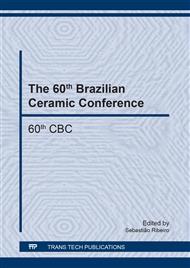p.12
p.16
p.21
p.27
p.33
p.39
p.44
p.50
p.55
Synthesis and Characterization of HMOR and Catalyst MoO3/HMOR, NiO/HMOR and Co2O3/HMOR
Abstract:
The mordenite zeolite is one of the most important industrially zeolites, used as a solid catalyst for various reactions hydrocracking, hydroisomerization, alkylation, reforming, alkane oxidation, Fischer-Tropsch reaction. The aim of this study was to hydrothermal synthesis mordenite zeolite in its sodium form under hydrothermal conditions, in organic-free synthesis. The form HMOR of the zeolite mordenite was obtained by an ion exchange. For the preparation of the catalysts precursor salts were used: ammonium heptamolybdate, nickel nitrate, cobalt nitrate dispersed from the impregnation by incipient wetness impregnation, such impregnated supports were calcined at 550 °C/4h to obtain the catalyst. The zeolite synthesized in the sodium form NaMOR in its ammonium form NH4MOR in form acid HMOR and their catalysts MoO3/HMOR, NiO/HMOR and Co2O3/HMOR were characterized by X-ray diffraction (XRD) and Fluorescence Spectroscopy of by Energy X-ray dispersive (FRX-ED). From the results it was possible to observe the formation of zeolite phase mordenite in its sodium and acid form and the effective impregnation and formation of the proposed catalysts.
Info:
Periodical:
Pages:
33-38
Citation:
Online since:
January 2018
Keywords:
Price:
Сopyright:
© 2018 Trans Tech Publications Ltd. All Rights Reserved
Share:
Citation:


